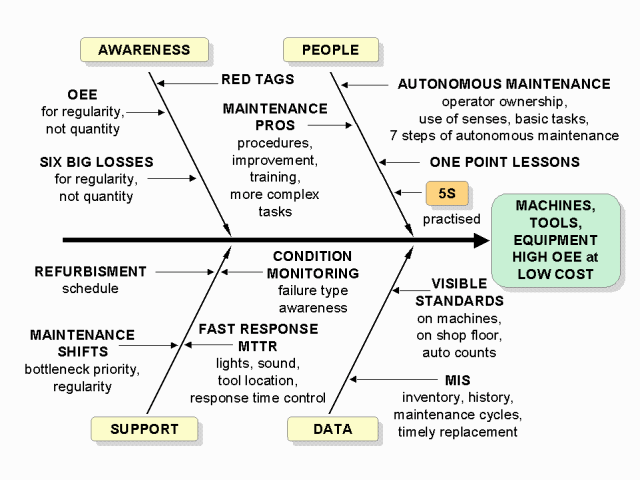
Lean and TOTAL MAINTENANCE

For Lean, machines, tools and equipment have to be available without fail when needed. Of course, cost is also important but if everyone participates, these two aims are not trade-offs. The phrase total productive maintenance emphasises that the concept goes beyond prevention to include improvement in productivity. Total productive maintenance has much in common with total quality. That is, both encourage participation by both experts and operators, both emphasise ownership, both take a process view, and both rely on good housekeeping.
Awareness is the starting point. Overall equipment effectiveness (OEE) is defined as:
This is a comprehensive view. Many companies display OEE graphs near critical machines; an overall graph and three supporting graphs, one for each factor. Below may be shown fishbone diagrams of contributing causes. Some management insist on OEE data before authorising capital expenditure: it may be better to improve rather than buy.
The Six Big Losses are the elements of OEE. Awareness helps prioritise.
Red Tags provide visible awareness of maintenance requirements. Tags, sometimes with dates, are hung on a board and returned to tbe machine when the required maintenance is complete. This provides an immediate visual impact of backlog.
TPM is ultimately a people programme. Autonomous Maintenance means operator responsibility for machines and operators carrying out as much routine maintenance work as possible. However, autonomous maintenance does not mean that it is voluntary. People come with built-in noise detection, vision, and vibration detection equipment. Use these precious capabilities and get operators to report anything unusual. 5S (see separate section) is an excellent way to get people involved in TPM.
Note: the term 'autonomous maintenance' is used by the Japan Institute of Plant Maintenance and includes 7 steps which are roughly similar to 5S:
One point lessons are TPM learning points for operators, where just one point is covered on a chart or sheet of paper. They provide focused learning and are applicable not only in maintenance.
Maintenance professionals should do the more skilled tasks. As they do this, OEE performance increases and a positive feedback loop is established. Freeing time should allow more operator training, and so on. The maintenance professionals, in consultasion with operators, should work out standard procedures.
Maintenance Shifts are a possibility in non-24/7 operations, but routine maintenance is essential everywhere. Bottlenecks should enjoy priority. A regular cycle of preventive maintenance should be maintained and recorded where appropriate (below).
A refurbishment plan, aiming to go beyond just routine preventive maintenance, where machines enjoy a new lease of life, is developed in accordance with usage.
Condition Monitoring, a relatively new activity monitors characteristics such as vibration and oil content to predict maintenance requirements. Failure type awareness is important for preventive maintenance - some machines have a 'bathtub' failure mode, some L shaped, others flat, others reverse L. Knowing the failure mode determines whether PM is a good idea and when to do it.
Fast Response and Mean Time to Repair are possibly more important than Mean Time to Failure because variation is reduced. Hence, monitor and record MTTR. Use red tags. Use light and sound to draw attention (Toyota plays operator-selected tunes). Tool location should reflect frequency of use.
Visible standards for maintenance should be kept by machines, using photographs and sketches. Even better, show normal settings on the machine itself. Use automatic part counters to change tools and replace parts with a known frequency.
Information Systems play an important role to record breakdown and problem data for subsequent improvement target actions or optimal replacement decisions.